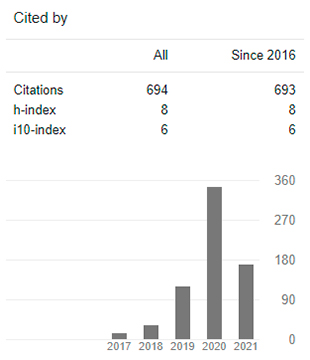Role of empathy in the work of psychologists and psychotherapists
DOI:
https://doi.org/10.29394/Scientific.issn.2542-2987.2020.5.E.7.146-164Keywords:
psychologists, psychotherapy, skillAbstract
Empathy is an important skill in the work of a psychologist and psychotherapist since it allows one to enter the world of the other and put oneself in their place. In this sense, Davis (1983): creates the Interpersonal Reactivity Index under this concept. The aim of this study is to evaluate the specific characteristics of empathy in Ecuadorian psychologists and compare it between men and women. A descriptive field study was carried out with a sample of 64 Ecuadorian psychologists. The statistical software IBM SPSS Statistics 20.0 and the Mann-Whitney U statistical significance test were used for the analysis of data to analyze gender and level of empathy. For the data collection, the empathic concern subscale of the Davis Interpersonal Reactivity Index adapted to the Spanish version was used. Most psychologists and psychotherapists have a high average level of empathy, however, this study did not see significant results in terms of gender difference and level of empathy, therefore, more research is required.
Downloads
References
Álvarez, P., Carrasco, M., & Fustos, J. (2010a,b,c). Relación de la empatía y género en la conducta prosocial y agresiva, en adolescentes de distintos tipos de establecimientos educacionales. Revista Iberoamericana de Psicología: Ciencia y Tecnología, 3(2), 27-36, e-ISSN: 2500-6517. Recuperado de: https://reviberopsicologia.ibero.edu.co/article/view/rip.3203
Bohart, A., & Greenberg, L. (1997). Empathy Reconsidered: New Directions in Psychotherapy. ISBN: 1557984107, ISBN: 9781557984104. Washington, D.C.: American Psychological Association.
Bordin, E. (1979a,b). The generalizability of the psychoanalytic concept of the working alliance. Psychotherapy: Theory, Research & Practice, 16(3), 252-260, e-ISSN: 1939-1536. Recovered from: https://doi.org/10.1037/h0085885
Bordin, E. (1994a,b). Theory and research on the therapeutic working alliance: New directions. In A. O. Horvath & L. S. Greenberg (Eds.), Wiley series on personality processes. The working alliance: Theory, research, and practice (p. 13-37). United States: John Wiley & Sons.
Bruce, N., Manber, R., Shapiro, S., & Constantino, M. (2010). Psychotherapist mindfulness and the psychotherapy process. Psychotherapy: Theory, Research, Practice, Training, 47(1), 83-97, e-ISSN: 1939-1536. Recovered from: https://doi.org/10.1037/a0018842
Davis, M. (1983a,b,c,d,e,f,g,h). Measuring individual differences in empathy: Evidence for a multidimensional approach. Journal of Personality and Social Psychology, 44(1), 113–126, e-ISSN: 1939-1315. Recovered from: https://doi.org/10.1037/0022-3514.44.1.113
Decety, J., & Lamm, C. (2009). Empathy versus personal distress: Recent evidence from social neuroscience. In J. Decety & W. Ickes (Eds.), Social neuroscience. The social neuroscience of empathy (p. 199–213). United States: MIT Press.
Dymond, R. (1949). A scale for the measurement of empathic ability. Journal of Consulting Psychology, 13(2), 127-133, e-ISSN: 1939-2117. Recovered from: https://doi.org/10.1037/h0061728
Eisenberg, N., & Strayer, J. (1987). La empatía y su desarrollo. Bilbao, España: Editorial Desclée De Brouwer.
Germer, C., Siegel, R., & Fulton, P. (Eds.). (2013). Mindfulness and psychotherapy. 2nd ed. Nueva York, United States: Guilford Press.
Hernández, R., Fernández, C., & Baptista, P. (2014). Metodología de la investigación. ISBN: 978-1-4562-2396-0. México D.F.: McGraw-Hill / Interamericana Editores, S.A. de C.V.
Hilari, A. (2017). Diferencias en la autorregulación emocional y la complejidad cognitiva en situaciones terapéuticas críticas entre terapeutas noveles y expertos. Tesis doctoral. Barcelona, España: Universitat Ramon Llull. Recuperado de: http://hdl.handle.net/10803/418809
Hoffman, M. (1977a,b). Sex differences in empathy and related behaviors. Psychological Bulletin, 84(4), 712-722, e-ISSN: 1939-1455. Recovered from: https://doi.org/10.1037/0033-2909.84.4.712
Hogan, R. (1969). Development of an Empathy Scale. Development of an empathy scale. Journal of Consulting and Clinical Psychology, 33(3), 307-316, e-ISSN: 1939-2117. Recovered from: https://doi.org/10.1037/h0027580
Kanfer, F., & Goldstein, A. (1987). Como Ayudar al Cambio en Psicoterapia. Bilbao, España: Editorial Desclée De Brouwer, S.A.
Lamothe, M., Rondeau. É., Malboeuf-Hurtubise, C., Duval, M., & Sultan, S. (2016). Outcomes of MBSR or MBSR-based interventions in health care providers: A systematic review with a focus on empathy and emotional competencies. Complementary Therapies in Medicine, 24, 19-28, e-ISSN: 0965-2299. Recovered from: https://doi.org/10.1016/j.ctim.2015.11.001
Mehrabian, A., & Epstein, N. (1972). A measure of emotional empathy. Journal of Personality, 40, 525-543, e-ISSN: 0022-3506. Recovered from: https://doi.org/10.1111/j.1467-6494.1972.tb00078.x
Mora, L. (2017). Planeación Transdisplinaria de Proyectos de Aprendizaje. Revista Scientific, 2(5), 140-159, e-ISSN: 2542-2987. Recuperado de: https://doi.org/10.29394/scientific.issn.2542-2987.2017.2.5.8.140-159
Moya, L. (2018). La empatía. ISBN: 9788417376246. Barcelona, España: Plataforma Editorial.
Norcross, J. (Ed.). (2011). Psychotherapy relationships that work: Evidence-based responsiveness. 2nd ed., ISBN 13: 9780199737208. New York, United States: Oxford University Press. Recovered from: https://doi.org/10.1093/acprof:oso/9780199737208.001.0001
Norcross, J., & Wampold, B. (2011). Evidence-based therapy relationships: Research conclusions and clinical practices. Psychotherapy, 48(1), 98-102 e-ISSN: 1939-1536. Recovered from: https://doi.org/10.1037/a0022161
Retuerto, A., (2004a,b,c,d). Diferencias en empatía en función de las variables género y edad. Apuntes de Psicología, 22(3), 323-339, e-ISSN: 0213-3334. Recuperado de: https://dialnet.unirioja.es/servlet/articulo?codigo=2217775
Richaud, M., & Mesurado, B. (2016a,b,c,d). Positive emotions and empathy as promotors of prosocial behavior and inhibitors of aggressive behavior. Acción Psicológica, 13(2), 31-42, e-ISSN: 2255-1271. Recovered from: http://dx.doi.org/10.5944/ap.13.2.17808
Rique, J., Camino, C., Formiga, N., Medeiros, F., & Luna, V. (2010). Consideração Empática e Tomada de Perspectiva para o Perdão Interpessoal. Interamerican Journal of Psychology, 44(3), 515-522, e-ISSN: 0034-9690. Recuperado de: https://www.redalyc.org/articulo.oa?id=28420658014
Siegel, D. (2010). The mindful therapist: a clinician's guide to mindsight and neural integration. 1st ed. New York, United States: W.W. Norton.
Singer, T., & Lamm, C. (2009). The Social Neuroscience of Empathy. Annals of the New York Academy of Sciences, 1156, 81-96, e-ISSN: 0077-8923. Recovered from: https://doi.org/10.1111/j.1749-6632.2009.04418.x
Worly, B., Verbeck, N., Walker, C., & Clinchot, D. (2018a,b,c,d): Burnout, perceived stress, and empathic concern: differences in female and male Millennial medical students. Psychology, Health & Medicine, 24(4), 429-438, e-ISSN: 1354-8506. Recovered from: https://doi.org/10.1080/13548506.2018.1529329
Downloads
Published
How to Cite
Issue
Section
License
The content of the journals of this site, are under a Creative Commons Attribution-Noncommercial-Share Alike 4.0 International License.













